Garlic
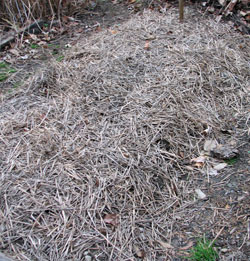 ©Janet Allen
©Janet Allen Garlic bed
Garlic is planted the year before so it comes up in the spring, ready to grow. After planting, which is traditionally done on or around Columbus Day, we cover the bed with straw or some other light mulch.
Garlic can also be planted in the spring although the harvested bulbs will tend not to be as large as those planted in the fall.
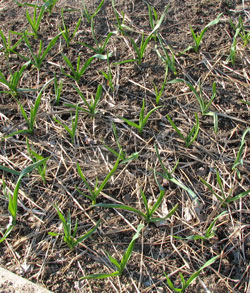 ©Janet Allen
©Janet Allen Young garlic plants
There's a high success rate. We don't recall a clove not developing into a new garlic plant.
We do have rich, well drained soil which one of the resources here says is a requirement for garlic.We have never had any pests bother the garlic and, in fact, one year planted single rows of garlic in each garden bed to ward pests away from the rest of the vegetables—along the lines of using garlic to keep vampires away. We don't have any evidence that it worked (for the pests) and find it more efficient to plant the garlic in one large bed. It is also easier to plan the rest of the garden if the garlic is in one place.
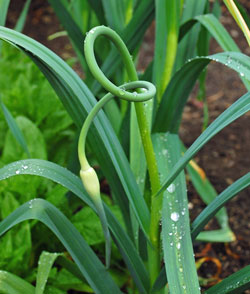 ©Janet Allen
©Janet Allen Garlic scapes
For many years we cut off and discarded these curly-ques at the top of each garlic stalk. Cutting them off was the proper thing to do since it wouldn't be good for the garlic plant to go to seed, but throwing away the "scapes"? What a waste! Before someone told us about it, we didn't know you could eat them. Then it took a few years to figure out what to do with them besides just sautéing them. Then we found a recipe—Garlic Scape Bean Spread. We love it! We freeze quite a bit of the spread and also the scapes for making spread later.
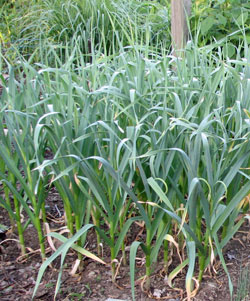 ©Janet Allen
©Janet Allen A bed of garlic
The garlic plants making food for the bulbs developing in the soil.
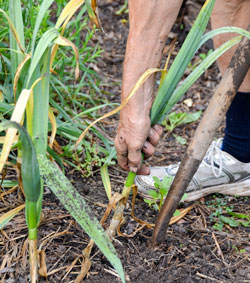 ©Janet Allen
©Janet Allen Harvesting garlic
When they turn yellow-brown in the summer, it's time to harvest. The rule of thumb we use is to harvest nine months after the garlic was planted. That would be around July 10th. Any garlic planted in the spring would be harvested at about the same time or perhaps a few weeks later.
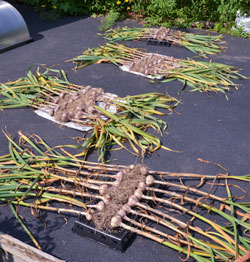 ©Janet Allen
©Janet Allen Garlic drying on the driveway
We initially place the harvested garlic on the driveway for a few hours so that it's easy to shake the dirt off their roots.
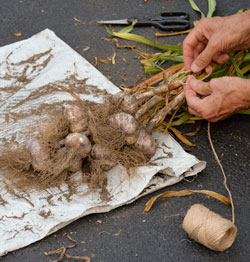 ©Janet Allen
©Janet Allen Tying up the garlic
We tie the garlic heads into bunches.
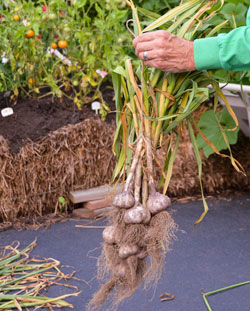 ©Janet Allen
©Janet Allen Ready for winter storage
Garlic is very productive and we used to grow enough to keep us going through the year. We now use a lot more garlic in cooking and haven't quite gotten production up to where it meets our needs.
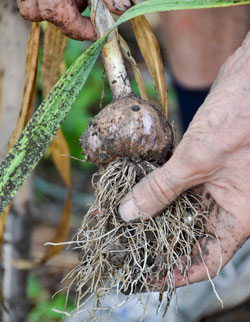 ©Janet Allen
©Janet Allen Saved for next year
Yes, we used to give into temptation and use the best heads for cooking, but now we save the best heads for replanting next year's crop.
Garlic problems
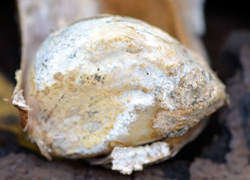 ©Janet Allen
©Janet Allen A clove from the diseased bulb
In 2014, we had a problem with some of our garlic—unusual since this has been a very dependable crop for us.
It didn't affect all the garlic, and we still had a good harvest, but we also had some bulbs that were rotted inside. We'll have to explore the causes of this problem.
Harvest record for garlic bulbs
| YR | LB | Notes |
| 15 | ||
| 14 | 17 | |
| 13 | 15 | |
| 12 | 10 | |
| 11 | 6 | |
| 10 | 7 | From here on, we started just weighing the bulbs |
| 09 | 18 | Includes the weight of the stalks |
Harvest record for garlic scapes
| YR | LB | Notes |
| 13 | 2 | There's never enough scapes — a very limited resource! |
| 12 | 2 | |
| 11 | 1 | |
| 10 | 2 | |
| 09 | 2 |
